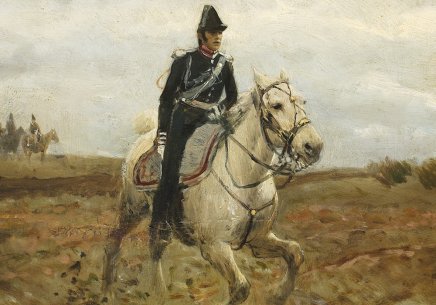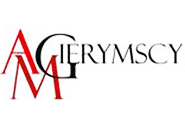
The National Museum in Krakow reminds the creative output of Maksymilian Gierymski (1846–1874), one of the most famous 19th-century Polish painters belonging to artists' colony in Munich. The 140th anniversary of the artist's death, which is celebrated this year, was the pretext for the exhibition. The artist, who died young, at the age of only 28, left creative output which inspired next generations of artists and was the beginning of the first Polish school of landscape painting.
The National Museum in Krakow does not only show works by Gierymski but also by other artists from Munich. Therefore, apart from 55 oil paitings, 55 works on paper by this artist, we also saw works by Polish, German, French and Hungarian painters:. including Józef Brandt, Adam Chmielowski, Józef Chełmoński, Stanisław Witkiewicz, Alfred Wierusz-Kowalski, Władysław Malecki, Eduard Schleich the Elder, Ludwig Hartmann and Mihály Munkács.
Apart from Maksymilian Gierymski's most famous works, such as "Adiutant sztabowy" ("Staff Adiutant"), "Konna kawalkada w brzezince" ("Cavalcade in a birch grove"), "Obóz Cyganów I" ("Gypsy camp I") or "Patrol powstańców"("Insurgent patrol"), the artist's last painting was also be presented "Polowanie »par force« na jelenia" ("Deer hunting »par force«") from the collection of the Kunsthalle in Kiel - and "Wiosna w małym miasteczku" ("Spring in a small town") (from a private collection in Buenos Aires) – long considered to have been lost, which was presented in Poland for the first time.
The exhibition at the National Museum in Krakow was consist of seven parts, each of which highlights the most important thematic threads in the artist's work. In this way, we saw his youthful works and paintings centring on the uprising theme. We become familiar with intimate landscape paintings, showing the artist's complex relation to nature, which is described as romantic realism. We saw the so-called Zopf [German der Zopf – plait], i.e. hunting scenes with Rococo costumes which were immortalized by Maksymilian Gierymski in paintings from the years 1871–1874, owing to which he got orders from rich clients. We were also enter the world of the artists' colony which was active in Munich in the 2nd half of the 19th century. Maksymilian Gierymski was shown in the company of artists who created during that period, who were inspired by his work and who he inspired.
The main axis of the exhibition is the artist's innovative approach to landscape painting. Genre scenes were often just a pretext to observe the landscape. It can already be noticed in his uprising scenes: he developed a modern formula of minimalist landscape, deprived of detail, which had not been known in Polish painting before. Subtle elaboration of the light and colour creates the mood of these paintings. The artist's approach expressed the romantic conviction about a special bond between people and nature.
Maksymilian Gierymski also immortalized the contemporary life of city and town inhabitants in his paintings, owing to which his works have a "documentary" character. He took care to define the time, geographical location and climatic conditions in his works - in accordance with the phrase which was attributed to him that "a painting should show the time, just like a clock". He was one of those artists for whom photographs, as the “depiction of a specific moment” - as he put it in letters to his family sent from Munich in which he asked for photographs presenting Polish landscape - became the starting point for work on a painting.
Maksymilian Gierymski's work was the first manifestation of realism in Polish painting. It started changes which occurred in the perception of the role of art, it broke away from the academic doctrine and undermined the convictions about patriotic obligations of Polish art. It inspired a whole generation of young artists (such as Stanisław Witkiewicz) and critics (such as Antoni Sygietyński).
In addition, a separate part of the exhibition included Cabinet of lost works. It contains multimedia materials presenting a selection of Maksymilian Gierymski's lost works, including paintings lost during World War II, including: "Alarm w obozie powstańczym" ("Alarm at an insurgent camp") from the collection of the pre-war Silesian Museum in Katowice, "Zima w małym miasteczku" ("Winter in a small time") from the collection of the National Museum in Krakow, "Wieczornica ukraińska" ("Ukrainian party") from the collection of the National Museum in Warsaw and "Pochód ułanów" ("Ulan march") from a private collection. Another group includes works whose location is not yet known, including "Powrót pana Tadeusza" ("Return of Tadeusz"), "Czerkiesi pędzący do ataku" ("Circassians rushing to attack"), "Pojedynek Tarły z Poniatowskim" ("Duel between Tarło and Poniatowski") and "Wypadek w podróży" ("Accident during a trip").
Before entering the exhibition, visitors had an opportunity to see the results of the first stage of research on Maksymilian Gierymski's painting technique and technology, which includes the artist's works from Polish museum collections.
This was the first exhibition of Maksymilian Gierymski's works since 1974, when an exhibition of the artist's works was presented at the National Museum in Warsaw, which was later also shown at the Central Pomerania Museum in Słupsk and the National Museum in Krakow.
Maksymilian, the elder brother of Aleksander Gierymski, an outstanding painter (1850-1901), showed artistic sensitivity since a child: he played the piano, was a great fan of Chopin and Wagner. Initially, he studied sciences (at the Polytechnic Institute of Agriculture and Forestry in Puławy and at the Mathematics and Physics Department of the Main School in Warsaw). He took part in the January Uprising. He probably fought in the Lublin and Kielce region.
This experience had a distinct influence on him, which could be later seen in his artistic work.
After coming back to the capital, he enrolled in the Drawing Class conducted by Wojciech Gerson and, after receiving a state scholarship, left for Munich were he studied painting. He was noticed by critics and collectors at the 1st International Art Exhibition in Munich in 1869. In the same year, his painting Rekonesans huzarów austriackich (Reconnaissance of Austrian hussars) was purchased for the collection of Emperor Franz Joseph. This was the beginning of his successes culminated with the gold medal at the World Exposition in Vienna in 1873.
In September 1874, he became member of the Royal Academy of Fine Arts in Berlin in recognition of his achievements. He died two weeks later.
The exhibition was accompanied by a comprehensive catalogue and guide as well as an educational program including: lectures, meetings, workshops, theme-centred guided tours, walks and publications. Together with the Education Department of the National Museum in Warsaw, we have prepared a publication which presents Aleksander and Maksymilian Giermyski's painting, shows reproductions of both brothers' works and describes the most important thematic and stylistic threads present in their work. At the entrance to the exhibition, a small educational booklet was available to visitors, which help them to get to know Maksymilian's painting in an interesting and active manner.
At the beginning of July, we invited visitors to see, open from March this year, an exhibition of Aleksander Gierymski's works at the National Museum in Warsaw and a walk in the brothers' footprints in their home town. The topics of lectures and meetings were focus on Gierymski's paintings which were lost during World War II, the artist's painting technique and the specificity of the conservation of his works as well as the uprising theme, the 19th century Munich circles and the issue of the "national artist" definition.
The works presented come from the following collections: the National Museum in Warsaw, the National Museum in Poznań, the Silesian Museum in Katowice, the Opole Silesia Museum in Opole, the Art Museum in Łódź, the District Museum in Toruń, the Upper Silesia Museum in Bytom, the West Pomerania Museum in Słupsk, the Museum of the Polish Army in Warsaw, the Museum of Independence in Warsaw, the District Museum in Rzeszów, the Branch of Graphic and Cartographic Materials of the Jagiellonian Library, the Ossolinski Publishing House in Wrocław, the Castle Museum in Pszczyna, the Kunsthalle in Kiel, the Biberach Museum, the Neue Pinakothek in Munich, the Musée d`Orsay in Paris, the Oblastni Galerie in Liberec, the Museum of Czech Literature in Prague, the National Gallery in Prague, the Hungarian National Gallery in Budapest and from private collections.
The "Gierymski Brothers" project carried out by the National Museum in Warsaw and the National Museum in Krakow.
An additional advantage of this exhibition project is the broadening of its scope, owing to the cooperation with the National Museum in Warsaw. Visitors of the Krakow exhibition devoted to Maksymilian Gierymski can become familiar with works by artist’s younger brother, Aleksander, presented from 20 March to 10 August 2014 at the National Museum in Warsaw at the "Aleksander Gierymski 1850–1901" exhibition.
The project "Work of Maksymilian Gierymski and the art of Polish artists in Munich in the years 1867–1900 – interdisciplinary research" is financed from the funds of the National Science Centre, implemented in the National Museum in Krakow.
The exhibition of the National Museum in Krakow closes the first stage of an interdisciplinary research projects combining the work of art historians, conservators and chemists. The aim of the project team is to collect, supplement and systematize data on Maksymilian Gierymski's works. Research work in the area of conservation and sciences will allow for defining selected techniques
and technologies which were used by Maksymilian Gierymski. It is conducted using non-invasive and non-destructive methods. The basis for the research are analyses in visible light (VIS), ultraviolet light (UV), infrared light (IR), in sodium light and x-rays (RTG). Observations in analytical light were supplemented by research using the XRF method (x-ray fluorescence spectrometry).


